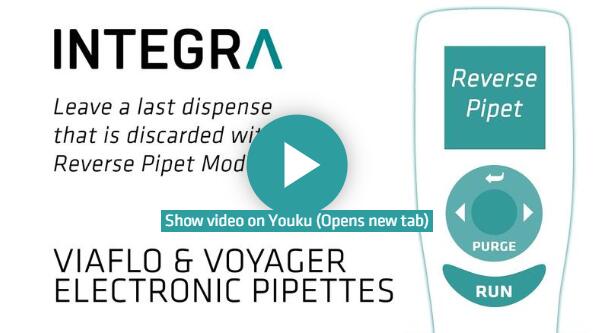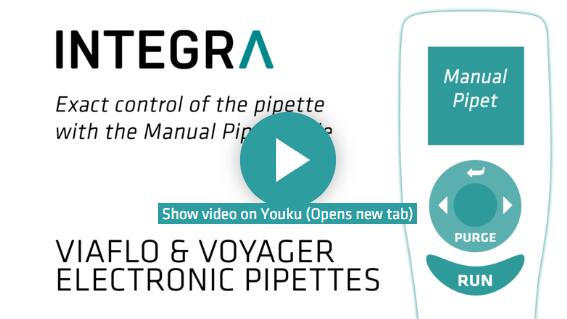Home > News > How INTEGRA’s electronic micropipettes make your lab life much better [Video tutorials]
How INTEGRA’s electronic micropipettes make your lab life much better [Video tutorials]
- The significance of user experience on pipetting precision is often overlooked, and can have a serious impact on the reproducibility and validity of results. The negative effects of many hours of repetitive pipetting on both the researcher and the results should also not be underestimated. That’s why so many researchers have switched to electronic micropipettes – such as our lightweight VIAFLO electronic pipettes and VOYAGER adjustable tip spacing pipettes – to improve their busy workflows. But are you fully aware of the capabilities of these electronic pipettes?
We want to make your daily pipetting tasks easier and faster, and help you to ensure your lab is following good pipetting practices. We’ve put together a series of ‘How to’ videos to show you how easy it is to get started with INTEGRA electronic pipettes, and just how productive you can be.
Loading GripTips
Generic pipette tips tend to loosen over time when pipetting, which can cause them to leak or fall off and lead to inaccurate results. Users often hammer the tips on to reduce this risk, resulting in high loading and ejection forces that increase the risk of repetitive strain injuries (RSIs).
That’s not the case with INTEGRA pipettes and GripTips! GripTips are designed to effortlessly attach and eject from the pipette, which means they never leak or fall off, and are perfectly fitted every time. This combination of our micropipettes and GripTips forms the perfect system, for all your pipetting needs.
Pipet mode
Plunger movement when using manual pipettes is dependent on the user, leading to variation in results.
Pipet mode is designed to help you precisely and accurately aspirate and dispense the exact same volume of liquid, in the same way, every time. This helps to improve the consistency of activities such as staining or aliquoting cells. Performing these tasks with electronic micropipettes also reduces the thumb movement required, minimizing the risk of RSIs.
Repeat dispense mode
Aliquoting large volumes of liquid into multiple containers or labware formats is a common laboratory task. It requires repetitive aspiration and dispensing – which can lead to fatigue and RSIs – and careful concentration, to avoid missing or duplicating a transfer.
Repeat dispense mode – or multi-dispensing – takes much of the strain out of these tasks and allows you to dispense multiple aliquots of the same volume without refilling the tips after each action. This dramatically reduces the number of pipetting steps, as you can perform several dispenses with a single aspiration. Repeat dispense is perfect for activities where your workflow requires precise aliquoting, such as adding buffers or PCR master mixes to 96 or 384 well plates, or medium to cell cultures.
Reverse pipetting mode
Pipetting of volatile or viscous solutions can be greatly improved by using a reverse pipetting technique. While this can be performed with manual pipettes, the need to precisely control pipetting speeds makes it difficult to achieve consistent results.
In reverse pipetting mode, slightly more than the desired volume of liquid is aspirated, meaning that a small excess stays in the tip after dispensing. This can improve your pipetting reproducibility for non-aqueous solutions, by minimizing the influence of effects such as evaporation in the tip. In addition, it helps to avoid air bubbles forming in the sample after pipetting, as is no ‘blow-out’ to fully evacuate the tip. You can also set the aspiration/dispense speed to fast or slow, for volatile or viscous solutions respectively, increasing pipetting precision for solutions like ethanol, DMSO or glycerine.
Pipet/Mix (mixing) mode
Manual mixing requires highly repetitive movement of the plunger, potentially resulting in fatigue and RSIs, as well as variations due to inconsistent mixing.
Mixing mode enables the aspiration of a specific amount of liquid followed by a user-defined mixing step. This program is ideal for increasing your reproducibility and preventing RSIs, as it minimizes manual plunger use during operation. Variable speed control enables efficient mixing for a range of workflows, from gentle mixing of cells or beads to vigorous blending of two aqueous liquids. Manual pipet mode
Determining the residual volume of sample or reagent in a vessel is difficult to achieve using gravimetric approaches.
Manual pipet mode enables you to manually control aspiration up to the set volume, with a real time readout on the display, making it easy to determine how much liquid is in a container or microplate well. This mode is also ideal for situations where delicate pipetting is required, such as supernatant collection during bead-based experiments.
Custom programs
Repetitive manual pipetting often leads to human error, as well as operator-to-operator variability. Combined with inconsistencies in the way different procedures and steps are performed by each researcher, this reduces the overall reproducibility and reliability of results.
Custom programs provide full flexibility to write and run your own protocols. Each INTEGRA electronic micropipette allows you to create and store of up to 40 multi-step pipetting protocols, ensuring the same process is followed by every user for consistent performance. You can even create complete workflows – including pipetting volumes and speeds, as well as mixing and incubation timing steps – to provide you with built-in SOPs for even advanced multi-step pipetting applications, increasing reproducibility between different operators.
VOYAGER adjustable tip spacing
The need to transfer liquids between different labware formats is common in many experimental workflows. As the spacing between these formats varies, it is impossible to use a standard multichannel pipette with fixed tip spacing when, for example, pipetting from centrifuge tubes to microplates. Many labs therefore rely on single channel pipettes, which is time consuming, increases the risk of RSIs, and has a high chance of leading to pipetting errors.
The VOYAGER is designed to overcome these issues by enabling you to electronically adjust tip spacing one-handed, at the touch of a button. This makes it ideal for applications such as gel loading or transferring biological samples – for example, from tubes to plates or from 96 to 384 well plates – and much more.
If any of the everyday challenges described here sound familiar, why not learn more about the benefits of electronic pipettes, and see how we can make your lab life easier.
Related News
- Biomoneta Becomes the First Indian Health-Tech Firms to Earn US-FDA Class II Cle 12/2/2025
- Thrombin Antibodies: How Does Aptamer Technology Revolutionize Anticoagulation T 12/1/2025
- The Key Role and Application Advances of IFN-γ Detection in CAR-T Cell Therapy D 11/30/2025
- FMC63 scFv: The Core Component of CD19-Targeted CAR-T Therapy and the Applicatio 11/29/2025
- Olympus Accelerates Local Production of the EVIS X1™ Endoscopy System in C 11/28/2025
- Minister Sridhar Babu Unveils the Next Wave of Growth for Genome Valley 11/26/2025
- Glycosylated Antibodies: How to Reveal Novel Diagnostic and Therapeutic Targets 11/26/2025
- BioMed X Announces New Neuroscience Research Collaboration in the USA 11/26/2025
- How to Achieve Precise Selection of IHC Antibodies in Cancer Biomarker Detection 11/25/2025
- Can FGFR2b Antibody Become a New Option for Targeted Therapy in Gastric Cancer? 11/24/2025










